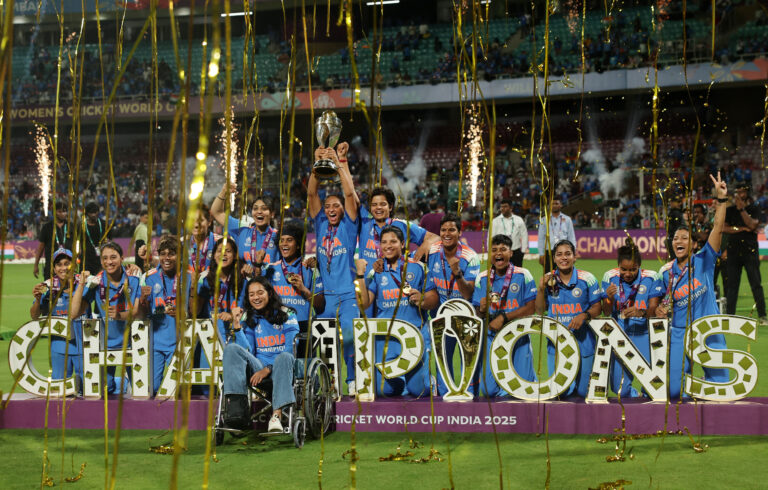
Following the extensive coverage of the above (India’s 2025 World Cup victory) in both Indian and international media, it would not be out of place to now examine its impact through the gender lens by addressing the following: To what extent does it reflect gender- parity for Indian women in team sports such as cricket by narrowing if not closing the gender gap. And secondly to what extent has it helped in reducing the social bias and stigma attached to women playing cricket.
As regards the first question, there are two differing viewpoints; there are those who point out that the cash reward of INR 51 crore announced by BCCI and the prize money of INR 40 crore by the ICC—totaling 90 crores to the women’s team– while narrowing the gap still falls short of gender- parity; as in comparison, the men’s team, which won the ICC T20 World Cup in 2024, received a much higher total of Rs 145.4 crore — Rs 20.4 crore from the ICC and Rs 125 crore bonus from the BCCI, which is about Rs 54 crore more than what the women’s team got this year. Since in the final analysis it is the quantum of financial resources available that determines the quality of training facilities and more significantly the financial independence it is able to bestow on the players, many of them coming from under privileged families.
Traditionally, for many years, both men and women cricketers had to be in the employ of Indian government undertakings such as the railways, to sustain their cricket careers. For example, both former and current captains– Mithali Raj and Harmanpreet Kaur, worked for the Railways. Kaur had moved to Mumbai in 2014, but to sustain herself, she had to work as a clerk in the Railways. In an online interview, she talked about how fatigued she was, travelling in the crowded suburban local trains in Mumbai to reach her place of work from home, leaving her exhausted by the time she reached her training facility. Deepti Sharma, another team-member is a DSP -deputy superintendent of police. Hopefully, the aforesaid cash awards and prize money– even after it is distributed equally to all team members– would place in their hands sufficient cash reserves to sustain a fulltime cricket career, without having to be in the employment of others.
Regarding the lack of gender parity, in the prize and cash awards, a differing viewpoint is held by Mithali Raj –who captained the team from 2004 to 2022—and who in a recent online interview said: “ We should stop comparing Men and Women’s prize money and look into the positives and good work done by the BCCI in organizing the 2025 World Cup; also, the evolution of men and women’s cricket is very different so you can’t compare money…. look at the standard of men’s cricket look at the number of events and tournaments they’ve won so far and they’ve been doing that for a long time… we’ve cracked it now so maybe in the next 10 years you probably will see the growth fast forward…”
As regards the second question relating to the social stigma attached to women playing cricket, this was brought out very graphically by the anchor person interviewing Mithali, who said: You referred to how when you would play, there would be people who would say “her skin will turn dark why are you torturing her?” Mithali responded:” when it comes to social media and trolls… over a period of time you find a way…. build a thick skin and don’t allow it to bother you..”
Quite often the supportive role of parents too goes a long way in defying conventional social norms. Aman Jot’s father — a carpenter– was taunted for encouraging his daughter to play cricket, but he stood by his daughter. In a ToI interview of 2017, parents of Kaur stated that “they aren’t conventional like other Punjab families in restricting the cricketer’s social life. They added that they have never asked their daughter to suggest a suitable time and age to marry…. Cricket first…Right from childhood, we wanted her to be a batsman. We can’t deny her right to build her career and ability to win laurels for India as a female star… “
The one big transformative societal impact the recent victory has had is to have established once and for all that women’s cricket in India, has come of age. It is no longer just a man’s sport, the space of which women have been trying to share over the years. It is also interesting to note that women’s sports in India are attracting more and more male viewership, as reportedly 58% of the 2025 world cup event was viewed by men.
==============================
 The author Nisha Sahai Achuthan, Ph.D., is a retired member of the Indian Administrative Service and a former executive head of the National Commission for Women, Government of India, now based in NYC as a Consultant.
The author Nisha Sahai Achuthan, Ph.D., is a retired member of the Indian Administrative Service and a former executive head of the National Commission for Women, Government of India, now based in NYC as a Consultant.



